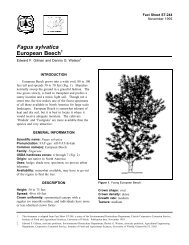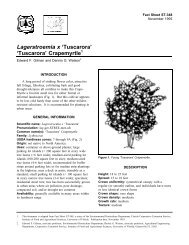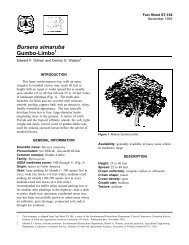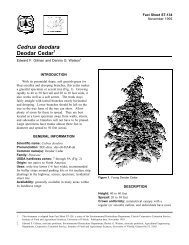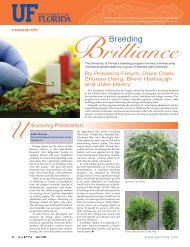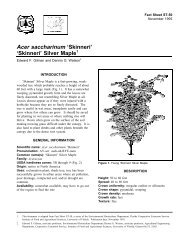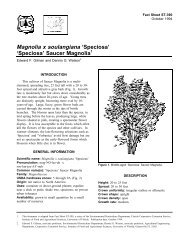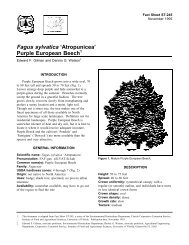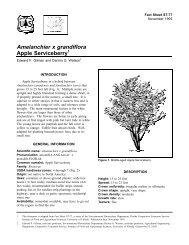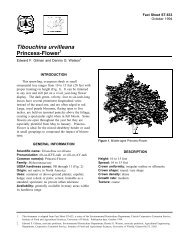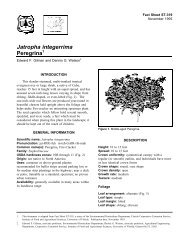Acer platanoides 'Crimson King' 'Crimson King' Norway Maple
Acer platanoides 'Crimson King' 'Crimson King' Norway Maple
Acer platanoides 'Crimson King' 'Crimson King' Norway Maple
Create successful ePaper yourself
Turn your PDF publications into a flip-book with our unique Google optimized e-Paper software.
<strong>Acer</strong> <strong>platanoides</strong> ‘Crimson King’<br />
‘Crimson King’ <strong>Norway</strong> <strong>Maple</strong> 1<br />
Edward F. Gilman and Dennis G. Watson 2<br />
INTRODUCTION<br />
‘Crimson King’ <strong>Norway</strong> maple grows to a height<br />
of 35 to 45 feet spreading about 25 to 30 feet and is<br />
quite popular for its purple-green foliage throughout<br />
the summer (Fig. 1). Leaves turn brown, dark maroon<br />
or bronze in the fall before dropping. The oval to<br />
rounded crown fills with maroon-yellow flowers in the<br />
spring. ‘Crimson King’ <strong>Norway</strong> <strong>Maple</strong>’s dense shade<br />
and shallow root system compete with lawn grasses,<br />
and the shallow roots can make mowing under the tree<br />
difficult.<br />
GENERAL INFORMATION<br />
Scientific name: <strong>Acer</strong> <strong>platanoides</strong> ‘Crimson King’<br />
Pronunciation: AY-ser plat-uh-NOY-deez<br />
Common name(s): ‘Crimson King’ <strong>Norway</strong> <strong>Maple</strong><br />
Family: <strong>Acer</strong>aceae<br />
USDA hardiness zones: 3B through 7 (Fig. 2)<br />
Origin: not native to North America<br />
Uses: Bonsai; large parking lot islands (> 200 square<br />
feet in size); wide tree lawns (>6 feet wide);<br />
medium-sized parking lot islands (100-200 square feet<br />
in size); medium-sized tree lawns (4-6 feet wide);<br />
recommended for buffer strips around parking lots or<br />
for median strip plantings in the highway; screen;<br />
shade tree; specimen; sidewalk cutout (tree pit);<br />
residential street tree<br />
Availability: generally available in many areas within<br />
its hardiness range<br />
Fact Sheet ST-32<br />
November 1993<br />
Figure 1. Middle-aged ‘Crimson King’ <strong>Norway</strong> <strong>Maple</strong>.<br />
DESCRIPTION<br />
Height: 35 to 45 feet<br />
Spread: 25 to 40 feet<br />
Crown uniformity: symmetrical canopy with a<br />
regular (or smooth) outline, and individuals have more<br />
or less identical crown forms<br />
Crown shape: oval<br />
Crown density: dense<br />
1. This document is adapted from Fact Sheet ST-32, a series of the Environmental Horticulture Department, Florida Cooperative Extension Service,<br />
Institute of Food and Agricultural Sciences, University of Florida. Publication date: November 1993.<br />
2. Edward F. Gilman, associate professor, Environmental Horticulture Department; Dennis G. Watson, associate professor, Agricultural Engineering<br />
Department, Cooperative Extension Service, Institute of Food and Agricultural Sciences, University of Florida, Gainesville FL 32611.
<strong>Acer</strong> <strong>platanoides</strong> ‘Crimson King’ -- ‘Crimson King’ <strong>Norway</strong> <strong>Maple</strong> Page 2<br />
Figure 2. Shaded area represents potential planting range.<br />
Growth rate: medium<br />
Texture: coarse<br />
Foliage<br />
Leaf arrangement: opposite/subopposite (Fig. 3)<br />
Leaf type: simple<br />
Leaf margin: lobed; dentate; incised<br />
Leaf shape: star-shaped<br />
Leaf venation: palmate<br />
Leaf type and persistence: deciduous<br />
Leaf blade length: 4 to 8 inches<br />
Leaf color: purple or red<br />
Fall color: yellow<br />
Fall characteristic: showy<br />
Flower<br />
Flower color: green<br />
Flower characteristics: inconspicuous and not<br />
showy; spring flowering<br />
Fruit<br />
Fruit shape: elongated<br />
Fruit length: 1 to 3 inches<br />
Fruit covering: dry or hard<br />
Fruit color: brown; green<br />
Fruit characteristics: attracts birds; no significant<br />
litter problem; showy<br />
Trunk and Branches<br />
Trunk/bark/branches: grow mostly upright and will<br />
not droop; not particularly showy; should be grown<br />
with a single leader; no thorns<br />
Pruning requirement: requires pruning to develop<br />
strong structure<br />
Breakage: resistant<br />
Current year twig color: brown<br />
Current year twig thickness: thick<br />
Culture<br />
Light requirement: tree grows in part shade/part sun;<br />
tree grows in full sun<br />
Soil tolerances: clay; loam; sand; acidic;<br />
occasionally wet; alkaline; well-drained
<strong>Acer</strong> <strong>platanoides</strong> ‘Crimson King’ -- ‘Crimson King’ <strong>Norway</strong> <strong>Maple</strong> Page 3<br />
Figure 3. Foliage of ‘Crimson King’ <strong>Norway</strong> <strong>Maple</strong>.<br />
Drought tolerance: moderate<br />
Aerosol salt tolerance: moderate<br />
Soil salt tolerance: good<br />
Other<br />
Roots: surface roots can lift sidewalks or interfere<br />
with mowing<br />
Winter interest: no special winter interest<br />
Outstanding tree: tree has outstanding ornamental<br />
features and could be planted more<br />
Invasive potential: No entries found.<br />
Verticillium wilt susceptibility: susceptible<br />
Pest resistance: long-term health usually not<br />
affected by pests<br />
USE AND MANAGEMENT<br />
It is well-adapted to street tree use but due to its<br />
bold leaf color may produce an overpowering, negative<br />
effect if planted along an entire street. It is probably<br />
best used as a shade tree or specimen or in a group<br />
tree planting to add accent to an area. Many types of<br />
birds are known to use the seeds as a food source, so<br />
it might be best located away from an area with park<br />
benches.<br />
The tree is easily transplanted, grows quickly and<br />
is adapted to a wide variety of soils (including slightly<br />
alkaline) and can tolerate shade, drought, and coastal<br />
conditions. It can naturalize if located close to open<br />
areas. Sensitive to poorly-drained soil, the tree<br />
responds well when planted in a mound with about<br />
one-third of the root ball above the existing soil grade.<br />
‘Crimson King’ is reportedly more difficult to<br />
transplant than the species but is considered an urban<br />
tough tree due to its adaptability. Trunks can crack on<br />
the southern and western sides during the winter.<br />
Roots can heave sidewalks so locate at least four to six<br />
feet away.<br />
See the species for a list of other cultivars of the<br />
species. ‘Crimson King’ may be more susceptible to<br />
pests than the species.<br />
Pests<br />
Aphids infest maples, usually <strong>Norway</strong> maple, and<br />
may be numerous at times. High populations can<br />
cause leaf drop. Another sign of heavy aphid<br />
infestation is honey dew on lower leaves and objects<br />
beneath the tree. Aphids are controlled by spraying or<br />
they may be left alone. If not sprayed, predatory<br />
insects will bring the aphid population under control.<br />
Scales are an occasional problem on maples.<br />
Perhaps the most common is cottony maple scale. The<br />
insect forms a cottony mass on the lower sides of<br />
branches. Scales are controlled with horticultural oil<br />
sprays. Scales may also be controlled with well-timed<br />
sprays to kill the crawlers.<br />
If borers become a problem it is an indication the<br />
tree is not growing well. Controlling borers involves<br />
keeping trees healthy. Chemical controls of existing<br />
infestations are more difficult. Proper control involves<br />
identification of the borer infesting the tree then<br />
applying insecticides at the proper time.<br />
Diseases<br />
Verticillium wilt symptoms are wilting and death<br />
of branches. Infected sapwood will be stained a dark<br />
or olive green but staining can’t always be found. If<br />
staining can not be found do not assume the problem<br />
is not verticillium wilt. Severely infected trees<br />
probably can’t be saved. Lightly infected trees<br />
showing only a few wilted branches may be pulled<br />
through. Fertilize and prune lightly infected trees.<br />
Fertilize with a high nitrogen fertilizer. This treatment<br />
will not cure the problem but may allow the tree to<br />
outgrow the infection. Girdling roots will cause<br />
symptoms which mimic verticillium wilt.<br />
Girdling roots grow around the base of the trunk<br />
rather than growing away from it. As both root and
<strong>Acer</strong> <strong>platanoides</strong> ‘Crimson King’ -- ‘Crimson King’ <strong>Norway</strong> <strong>Maple</strong> Page 4<br />
trunk increase in size, the root chokes the trunk.<br />
Girdling roots are detected by examining the base of<br />
the trunk. The lack of trunk flare at ground level is a<br />
symptom. The portion of the trunk above a girdling<br />
root does not grow as rapidly as the rest so may be<br />
slightly depressed. The offending root may be on the<br />
surface or may be just below the sod. The tree crown<br />
shows premature fall coloration and death of parts of<br />
the tree in more serious cases. If large portions of the<br />
tree have died it may not be worth saving. Girdling<br />
roots are functional roots so when removed, a portion<br />
of the tree may die. When the girdling root is large<br />
the treatment may be as harmful as the problem. After<br />
root removal, follow-up treatment includes<br />
fertilization, and watering during dry weather.<br />
Leaf scorch occurs during periods of high<br />
temperatures accompanied by wind. Trees with<br />
diseased or inadequate root systems will also show<br />
scorching. When trees do not get enough water they<br />
scorch. Scorch symptoms are light brown or tan dead<br />
areas along the margins or between leaf veins. The<br />
symptoms appear on all parts of the tree or only on the<br />
side exposed to sun and wind. Scorching due to dry<br />
soil may be overcome by watering. If scorching is<br />
due to an inadequate or diseased root system, watering<br />
will have no effect.



